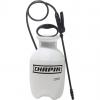- Always lower and fold up the Bimini when trailering the boat. The frame isn’t designed to take 55 mile per hour wind-blast, and trailering with it up will cause it to shimmy back and forth (loosening mounts and joints), may even bend the pipework, and will turn any tiny rips in the fabric into massive tears.
- Spray the fabric down every spring with a canvass protectant/waterproofer. Make sure you do this early in the day so it has plenty of time to dry (you’ll need to give it a thorough wash-down prior to application). Some of these sprays require hours to dry properly, so don’t do this just before a fishing trip. If your boat doesn’t have sufficient hand-holds, add them.
- A common way Biminis get damaged is when people hold onto them for stability, while the boat is running through waves—which puts the frame through far more stress than it’s designed for. Watch your Bimini as your boat cruises. If it shakes from side to side add some supports, even if all you can use is straps. If you allow the side to side motion to continue unabated, the mounts and joints will loosen over time.
- Use a mild soap but NEVER detergents, and give the canvass a gentle scrub-down every month or so. Getting off the dirt and especially bird droppings, which are acidic and will stain the canvass and ruin its waterproofing properties, has a big impact on how long your Bimini will last.
- Regular exposure and cleaning can diminish the water repellency of certain bimini top canvas over time. The water repellent finish used on most bimini top canvas allows water to bead and run off similar to that of a waxed car. When water beading diminishes, we recommend the use of Dry Guy Outdoor Clothing Waterproofing Spray after a thorough cleaning to restore the water repellency of your canvas.
BONUS TIP: Many Biminis have zippers for side curtains or storage boots. These often become difficult to use after a matter of months, but that’s because boat owners rarely lubricate them. To help unstick your zipper, you can add lubrication to the zipper teeth using chapstick, crayon wax, the end of a graphite pencil, petroleum jelly, and other waxy products or lubricants. For all of these uses, make sure to do a spot test to ensure that the material you're using won't permanently stain the fabric.



















Comments